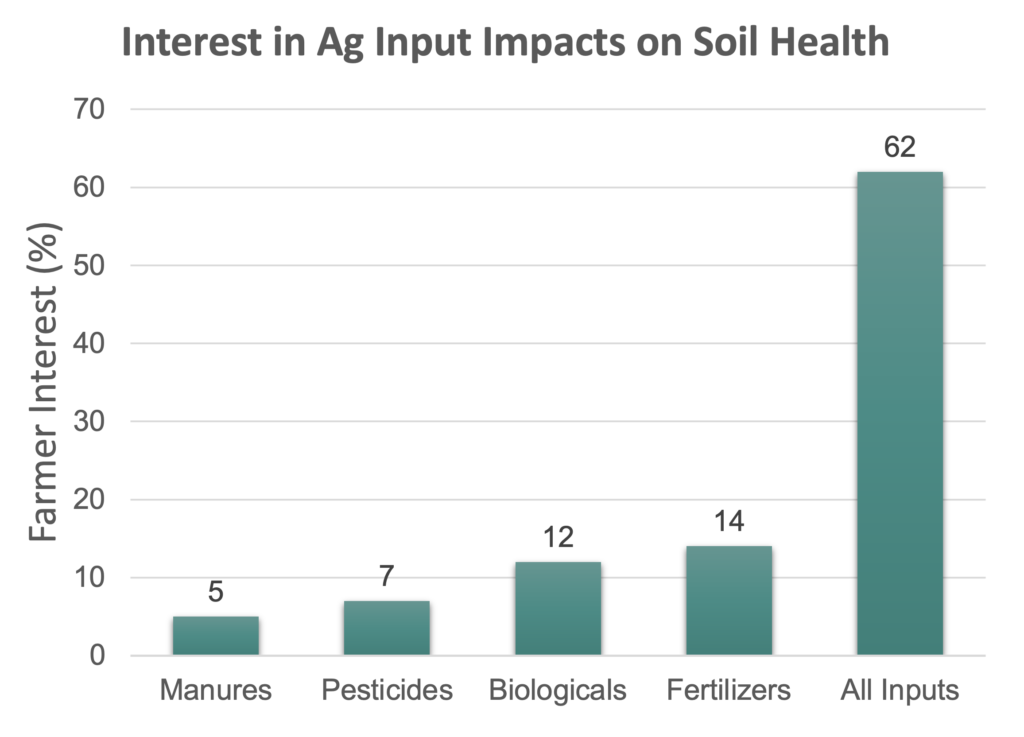Introduction
Farmers around the world are increasingly focused on improving the health of their soils. This interest is well placed because healthy soils generally have more plant-available nutrients, are more drought resilient, more disease suppressive, and more profitable. Management systems that improve soil health also benefit the environment by sequestering more carbon, reducing greenhouse gas emissions, reducing nutrient runoff and leaching, and even providing habitat for pollinators and other wildlife. As more farmers are investing to improve the health of their soils, questions are arising as to how agricultural inputs impact soil health. To determine the level of interest in this issue by farmers, this project was conducted with the following objective:
Objective
To assess U.S. farmers’ interest in the impact of agricultural inputs on soil health.
Approach
The Soil Health Institute partnered with Farm Journal’s Trust in Food to assess farmer interest in this topic using three different approaches, namely, a mobile message survey, content consumption analysis, and engagement tracking of custom content, as detailed below.
- Survey – A mobile message survey was sent to 10,000 U.S. farmers operating 100 or more acres. The survey was distributed to:
- 3500 corn/soybean farmers,
- 3500 wheat/barley/oat farmers,
- 1500 cotton/peanut farmers, and
- 1500 fruit/vegetable (specialty crop) farmers.
The first question asked in the survey was: “Are you interested in knowing the impact of agricultural inputs
on soil health?” For those answering “Yes”, two follow up questions were asked:
- Which inputs are you most interested in learning about its impact on soil health?
- Biologicals
- Fertilizers
- Manures
- Pesticides
- All of the above
- What do you grow or raise on your farm?
- Row crops
- Specialty crops
- Livestock
- Livestock and crops
For those answering “No”, the only follow up question asked was which crops they grow on the farm.
- Content Consumption – To assess the levels that readers are consuming information related to agricultural inputs, soil health practices, and an overlap between the two; lists of keywords were developed for both content categories and analyzed across a random sample of 10,000 AgWeb users. The keywords for each content category were:
Agricultural Input Keywords Soil Health Keywords fertilizer chemical(s) no-till water holding capacity pesticide foliar minimum till biology herbicide acephate conservation tillage microbiology fungicide chlorpyrifos cover crops density insecticide flutifol soil organic matter erosion N, nitrogen mancozeb carbon compaction P, phosphorus chlorothalonil nitrification crusting K, potassium dicamba nitrate soil-born disease potash glyphosate bacteria infiltration sulfur glufosinate fungi earthworms phosphate ammonium nematode microbial activity anhydrous 2,4-D nutrient management enzymes biologicals atrazine soil fertility manure propazine soil health litter simazine - Engagement Tracking – The third tactic used to assess farmer interest was to create written content on the impacts of agricultural inputs on soil health and track reader engagement with that content. Our partner, Farm Journal, wrote two articles entitled “Crop Inputs and Soil Health: How Do They Interact?” and “How Does Conservation Ag Impact Soil Health and Farm Economics?” Both articles were published on AgWeb and in Farm Journal newsletters. Farm Journal personnel then tracked the number of page views and time spent on each page.
Results
- Of the 10,000 farmers surveyed, 969 responded, for a response rate of 9.69%.
- 66% of farmers responding said “Yes”, they are interested in the impact of agricultural inputs on soil health, while 34% said they are not.
- Of the farmers interested in this topic, 5% were most interested in learning about the impacts of manure, 7% were most interested in learning about the impacts of pesticides, 12% were most interested in biologicals, 14% were most interested in fertilizers, and 62% were interested in all categories of inputs.
- Those interested in the effect of agricultural inputs were nearly equally divided between Row Crop farmers (44%) and Livestock and Crop farmers (43%), while those not interested in this topic were also predominantly Row Crop farmers (53%) and Livestock and Crop farmers (38%).
- Analyzing the levels of information consumed by a random sample of 10,000 AgWeb users showed that those farmers who are interested in both agricultural inputs and soil health consume 34% more digital information than the whole group, 45% are early adopters (which is 25% more than the whole group), operate 446 more acres than the whole group, and have a median income $144,410 greater than the whole group.
- Farmers were very interested in the interaction between agricultural inputs and soil health.

Summary & Conclusion
With interest in soil health and regenerative agriculture continually increasing among farmers, food and beverage companies, environmental groups, and agricultural commodity organizations, the Soil Health Institute partnered with Trust in Food to assess U.S. farmers’ interest in the impact of agricultural inputs on soil health. Trust in Food used a combination of survey questions, analysis of published content on the topic, and tracking farmers’ engagement when articles on the topic were posted to AgWeb. The survey was sent to 10,000 farmers across the U.S. who operate at least 100 acres. Notably, 66% of respondents said they are interested in the impact of agricultural inputs on soil health, and when those farmers were asked to rate their interest in the effects of manure, pesticides, biologicals, or fertilizer; 62% responded that they are interested in all of these inputs. Those farmers expressing an interest in both soil health and agricultural inputs were generally found to be early adopters that consume more digital information, operate more farm land, and have a higher median income than other farmers.